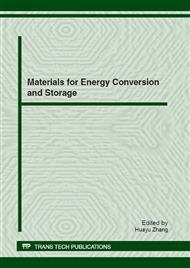[2]
Q. Z. Chen, A.R. Boccaccini, H. B. Zhang, D. Z. Wang, M. J. Edirisinghe, Improved mechanical reliability of bone tissue engineering scaffolds by electrospraying, J. Am. Ceram. Soc. 89 (2006) 1534-1539.
DOI: 10.1111/j.1551-2916.2006.00935.x
Google Scholar
[3]
Q. S. Ma, Y. Ma, Z. H. Chen, Fabrication and characterization of nanoporous SiO(2) ceramics via pyrolysis of silicone resin filled with nanometer SiO2 powders, Ceram. Int. 36 (2010) 2269-2272.
DOI: 10.1016/j.ceramint.2010.07.020
Google Scholar
[4]
H. Wang, X. D. Li, L. Y. Hong, D. P. Kim, Preparation of phenolic resin derived 3-D ordered macroporous carbon, J. Porous Mat. 13 (2006) 115-121.
DOI: 10.1007/s10934-006-7006-9
Google Scholar
[5]
Y. Ma, Q. S. Ma, Z. H. Chen, Low-temperature fabrication and characterization of porous SiC ceramics using preceramic polymer as binder, Rare Metal Mat. Eng. 36 (2007) 531-533.
Google Scholar
[6]
K. H.Jack, Review sialons and related nitrogen ceramics, J. Mater. Sci. 11 (1976) 1135-1158.
DOI: 10.1007/bf02396649
Google Scholar
[7]
A. J. Pyzik, D.R. Beaman, Microstructure and Properties of Self-Reinforced Silicon Nitride, J. Am. Ceram. Soc. 76 (1993) 2737-2744.
DOI: 10.1111/j.1151-2916.1993.tb04010.x
Google Scholar
[8]
P. F. Becher, E. Sun, K. P. Plucknett, K. B. Alexander, C. H. Hsueh, H. T. Lin, S. B. Waters, C. G. Westmoreland, E. S. Kang, K. Hirao, M. E. Brito, Microstructural Design of Silicon Nitride with Improved Fracture Toughness: I, Effects of Grain Shape and Size, J. Am. Ceram. Soc. 81 (1998) 2821-2830.
DOI: 10.1111/j.1151-2916.1998.tb02702.x
Google Scholar
[9]
F. L. Riley, Silicon nitride and related materials, J. Am. Ceram. Soc. 83 (2000) 245-265.
Google Scholar
[10]
A. R. Studart, U. T. Tonzenbach, E. Tervoort, L. J. Gauckler, Processing routes to macroporous ceramics: a review, J. Am. Ceram. Soc. 89 (2006) 1771-1789.
DOI: 10.1111/j.1551-2916.2006.01044.x
Google Scholar
[11]
T. Hao, Q. S. Ma, Effects of exterior gas pressure on the structure and properties of highly porous SiOC ceramics derived from silicone resin, Mater. lett. 66 (2012) 13~15.
DOI: 10.1016/j.matlet.2011.08.051
Google Scholar
[12]
T. Hao, Q. S. Ma, Effects of heating rate on the structure and properties of highly porous SiOC ceramic foams derived from silicone resin. Ceram. Int. 38 (2012) 2101-2104.
DOI: 10.1016/j.ceramint.2011.10.048
Google Scholar
[13]
M. D. M Innocentini, P. Sepulveda, V. R. Salvini, V. C. Pandolfelli, Permeability and structure of cellular ceramics: a comparison between two preparation techniques, J. Am. Ceram. Soc. 81(1998) 3349-3352.
DOI: 10.1111/j.1151-2916.1998.tb02782.x
Google Scholar
[14]
X. He, X. G. Zhou, B. Su, 3D interconnective porous alumina ceramics via direct protein foaming, J. Mater. Lett. 83(2009) 830-832.
DOI: 10.1016/j.matlet.2008.12.021
Google Scholar
[15]
L. Yin, H.X. Peng, S. Dhara, L. Yang, B. Su, Natural additives in protein coagulation casting process for improved microstructural controllability of cellular ceramics, Composites: Part B. 40(2009) 638-644.
DOI: 10.1016/j.compositesb.2009.04.016
Google Scholar
[16]
I. Garrn, C. Reetz, N. Brandes, L.W. Kroh, H. Schubert, Clot-forming: the use of proteins as binders for producing ceramic foams, Jour. Eur. Ceram. Soc. 24(2004) 579-587.
DOI: 10.1016/s0955-2219(03)00259-0
Google Scholar
[17]
X. He, B. Su, X. G. Zhou, J. H. Yang, B. Zhao, X. Y. Wang, G. Z. Yang, Z. H. Tang, H. X. Qiu, Gelcasting of alumina ceramic using an egg white protein binder system, Ceram. Silik.55(2011) 1-7.
Google Scholar
[18]
O. Lyckfeldt, J. Brandt, S. Lesca, Protein forming-a novel shaping technique for ceramics, J. Eur. Ceram. Soc. 20 (2000) 2551-2559.
DOI: 10.1016/s0955-2219(00)00136-9
Google Scholar
[19]
A. Berthold, H. Schubert, N. Brandes, L. Kroh, R. Miller, Behaviour of BSA and of BSA-derivatives at the air/water interface, Colloids and Surfaces A: Physicochem. Eng. Aspects. 301 (2007) 16-22.
DOI: 10.1016/j.colsurfa.2006.11.054
Google Scholar
[20]
Q. Li, X. W. Yin, Effects of phase composition on microstructure and mechanical properties of Lu2O3-doped porous silicon nitride ceramics, J. Mater. Sci. Technol. 27 (2011) 529-533.
DOI: 10.1016/s1005-0302(11)60103-5
Google Scholar
[21]
F. Ye, J. Y. Zhang, H.J. Zhang, L. M. Liu, Effect of sintering temperature on microstructure and mechanical properties of highly porous silicon nitride ceramics produced by freeze casting, Mater. Sci. Eng. A. 527(2010):6501-6504.
DOI: 10.1016/j.msea.2010.07.038
Google Scholar


